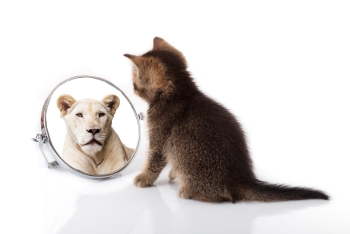
Therapy in Philadelphia: Mirror checking and the traps for Body Dysmorphic Disorder
Mirror checking is a common ritual performed by people with body dysmorphic disorder (BDD). Close to ninety percent of individuals with body dysmorphic disorder (BDD) have an unhealthy relationship with mirrors, where they excessively check their appearance, often for long periods of time. Some may be so dependent on mirror checking that they use anything with a reflective surface: a car window, computer screens, someone else’s shadow, a picture frame, etc. The drive for mirror checking is the same with any ritual related to body dysmorphic disorder (BDD), involving one of two reasons:1) They are checking the mirror to ease their fears about how they think they look, or 2) They are using the mirror to confirm that their perceived flaw is still there, and/or is still as bad as they recall.
The practice of mirror checking is a slippery slope. What is meant to be a brief glance in the mirror, often becomes a long and torturous up-close examination of perceived flaws, and constant obsession on how to improve one’s appearance. This ritual can leave individuals obsessing in front of the mirror for anywhere between 10 minutes, to multiple hours, because their hope to see something different turned into fear and panic, and the compulsion to fix their flaw. Mirror checking is not only time consuming, but often increases anxiety. The exact behaviors with mirror checking for a person with body dysmorphic disorder (BDD) can vary from dissecting their appearance and problem areas, to other rituals like skin picking (hyperlink in the future), reapplying makeup or rearranging their makeup, hair, etc. to mask their identified flaws.
Mirror checking provides only short-term relief from one’s pain and anxiety around their body dysmorphic disorder (BDD), if any. Regardless of the number of positive experiences you may have during your mirror checking, this behavior is not the solution to your body dysmorphic disorder (BDD) symptoms. In fact, it’s a significant part of the problem. If you feel better after looking in the mirror, when you have body dismorphic disorder (BDD), the positive is only temporary, and soon you are triggered again, fixated on what you identify to be negative aspects of your appearance. Other times looking in the mirror will just confirm what you were afraid of, that you don’t like what you see, which will leave you feel worse than you did before you stepped in front of the mirror. Mirror checking brings a big risk, yes, today might be the day you look in front of the mirror and feel good about what you see. However, with that chance, comes the possibility that you will feel worse than before, finding yourself trapped in front of the mirror, analyzing, fixing, and missing out on living your life. When individuals get stuck or fixated on any issue too long, our stress level increases which impacts our brain’s functioning, impairing our ability to fully function in a rational manner. Meaning, the longer you stand in front of a mirror focusing on details of your appearance up close, the more likely you will begin to have a distorted view of what you’re really dealing with. To help break this cycle some people opt to avoid all mirrors. For some, this might be a good first step, however it also misses the real goal of a mind-body connection. Mirrors do provide useful feedback, if used in moderation and for the right reasons. The goal is to have a balanced, healthy relationship with mirrors. What this would look like is putting your life (friends, family, job, hobbies) first before any mirror checking, and having the ability to refrain from compulsive, time-consuming mirror checking.
If you are unsure about how severe your mirror checking is, track this behavior for the next seven days. Use a calendar, or a journal, and record each time you resort to mirror checking, how long you spend checking your appearance in the mirror, and what specifically you were fixated on, and where in Center City Philadelphia you are. Be as specific and as detailed as possible. Be a detective, try to get as much as the “who, what, when where” of your mirror checking. Before and after you mirror check, on a scale from one to ten, rate your level of distress re: your appearance (10 being most distressed, 1 being none at all). Compare your before and after scales to each other to give yourself a better idea of how much mirror checking impacts your symptoms and mood. If you want to be even more thorough in your information gathering, also check-in and rate your distress level fifteen minutes after you have checked the mirror. Most likely, if you ranked a lower distress level immediately after mirror checking, your distress level will have changed fifteen minutes later. Do you recognize any themes when you rate your distress level? Are you more distressed after completing your ritual most of the time? Or do you notice your distress level stays the same? Most likely this scale will reveal your anxiety and stress over your appearance increases after mirror checking. If not, then continue to rank your distress level throughout the day, when are you the most distressed about your BDD? This type of therapy activity can help you see for yourself the severity and impact of something as seemingly harmless as mirror checking. Ask those around you (friends, family, co-workers you find trustworthy) if they are aware of your mirror checking. Do they find it distracting? Or do they find it to be a barrier between you two? Often, it’s difficult to connect and be intimate with someone who is preoccupied and fixated on their appearance.
If you are ready to make a change in your mirror checking, it’s best to start simple. Limiting the amount of time and frequency you spend behind the mirror will help you practice the skill of curbing your behaviors and resisting urges. If you check your appearance in the mirror six times a day about thirty minutes each time, cut the activity in half to three times a day at fifteen minutes each behind the mirror.
For example, if you typically spend fifteen minutes every morning inspecting your hairline, set a goal for cutting your time to eight minutes, every other morning. In order to successfully resist the urge on the mornings you plan to skip your ritual, either shift or add a new task to your morning routine. For example, use the fifteen minutes you would typically spend in the mirror going for a walk. Or, spend that time outside or in your favorite place in your home to journal about your experience without the mirror that morning, or make a more elaborate breakfast than you typically do in the morning as a reward. These additional coping skills not only serve as a way to occupy your time, but provide you with new outlets to apply your skills, focus, and energy. In most cases, when we are trying to break any habit, like smoking, or skipping dessert after dinner, making a change in the routine helps reduce triggers to carry out the behavior.
In order to reduce the frequency of mirror checking, apply this therapy behavior change process throughout the day. For example, if you take breaks during the day at work to check your appearance in the bathroom mirror, plan ahead alternative activities to replace your mirror checking: take a walk around the block or in your office building, walk with a co-worker for coffee, use your new-found time to go out and get lunch somewhere new.
This is just one of the many rituals someone with BDD may have. Rating your distress level can be used for any of your other rituals if you are curious about their frequency and severity. This may not be the only step you need, but it is the first step in addressing your unhealthy relationship with the mirror. If you are looking for more help to address your BDD, help is available today. Call The Center for Growth / Eating Disorder Treatment in Philadelphia 267-324-9564

























